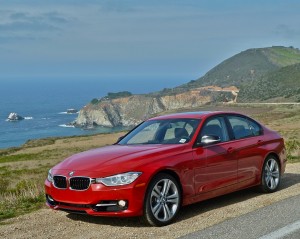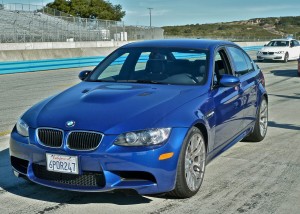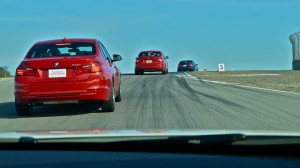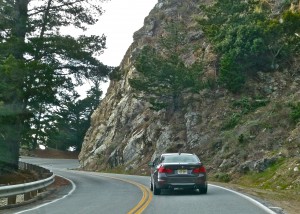BMW 3-Series dazzles at introduction
By John Gilbert
MONTEREY, CALIF. — All is fair in love, war, and new car introductions, apparently. But if it’s BMW, some things seem unfair. BMW summoned North American auto writers for first test-drives of the sixth generation BMW 3 Series. We knew going in we were going to be driving the latest iteration of a sedan that every other car maker identifies as the benchmark they used for any new vehicle.
First impression shows a refined kidney-shaped grille, with headlights that are stretched horizontally, enclosed in an elongated housing that reaches from the outer edges to the grille, and they are overlined with a sloping line that changes the personality of the car. BMWs always have looked a little bit like raptors, face on, and the new 3 looks more like an extra-aggressive and maybe hungry raptor on the prowl, capable of diving and pouncing on its prey from wherever it chooses.
It looks larger because it is, and its power now comes from a pair of highly refined turbocharged engines — either a 2.0-liter 4-cylinder, giving the 328 model 240 horsepower at 5,000 RPMs and 260 foot-pounds of torque at a mere 1,250 RPMs, or the familiar 3.0-liter in-line 6, with 300 horsepower at 5,800 RPMs and 300 foot-pounds of torque holding that peak from 1,250 to 5,000 RPMs. A 6-speed manual or 8-speed automatic — smooth-shifting, but not a direct-sequential twin-clutch device — which can be upgraded to a sport package with steering wheel paddles to manually make or hold shifts. The smooth abundance of power indicates BMW has maintained its perch at the top of my personal rating of auto-world technology.
There are three trim groupings, with the Sport Line identifiable by 8 high-gloss black vertical bars in its grille, the Luxury Line with 11 chrome bars, and the Modern Line with 11 satin-silver bars. There are more exceptions than models, however, because you can get the 4 or the 6 in any version, and you can upgrade to sport application if desired. Also, a wagon version is coming, and so are a hybrid, a pure-electric version, and the highest-performing M3, all of which should be showing up by the end of summer. There will be no diesel for the 2012 calendar year.
Prices provoke my old axiom for BMW. The 328i with the 4 starts at $35,795, and the 335i with the 6 starts at $43,295. My axiom about the cost of a BMW: “Exorbitantly priced, but worth every penny.”
The other “unfair” tricks BMW used was to hold the introduction at Monterey, Calif., a wonderfully contemporary and stylish Pacific Coast town, which is pretty much a highlight itself. Part of our test drive would be conducted on the Mazda Laguna Seca race track, a legendary series of twists, turns, breathtaking rises, and breath-losing dives in elevation. It is one of the great race tracks of the world, let alone the U.S., and since I had watched a race and visited Laguna before, but had never driven on it.
The one race I saw there was a CART Indy-car-style race, back when CART was far outperforming the Indy Racing League. In that race, Alex Zanardi overtook race leader Bryan Herta on the final lap, at the top of the highest hill, and passed him on the inside as they approached the track’s signature “Corkscrew.” It was impossible to simply pass at that point, and Zanardi proved why, by skidding off on the far side of the track, regaining control on the far shoulder, and staying on the shoulder as he plunged down the cliff-like drop. He wound up ahead of Herta, and held on to win to most spectacular finish in CART history.
As alluring as the race track was, the second half of the introductory drive would be along California’s legendary Hwy. 1, south from Monterey to the Big Sur area. I’ve made that drive a time or two, and every time I think about it, I can’t help but remember an old Kingston Trio song, “South Coast,” which tells the sad and haunting tale of a relationship interrupted by a mountain lion, which still rules the lonely cliffside region. On my first drive there, I spotted a gigantic raptor overhead and guessed that it might be a California Condor. My guess was based on the tiny, sparrow-looking birds near it, which I recognized as red-tail hawks. Turned out to be correct, affirmed by a DNR worker nearby, who told us that it was one of only four in the entire California area.
The track is as good as race tracks get, and the cliffside drive to Big Sur is as good as scenic drives can get, right up there with Lake Superior’s rugged North Shore, so it was with great anticipation that I climbed into the BMW 3 Series sedan — the newest version of the acknowledged industry best. The bar was extremely high to start our trip, and all of the elements of the trip lived up to, or exceeded, all expectations.
With roots dating back to the old 1600 and 2002 BMW compact sedans, the first actual 3-Series car was introduced in 1975. It was replaced in 1982, again in 1990, then in 1999, with the fifth generation coming out in 2005. For 2012, the sixth generation won’t reach dealerships until late February, but it’s obvious that BMW’s excellence has allowed the Bavarian company, based in Munich, to stick with models far beyond the normal four or five-year cycle. Perhaps the best evidence of BMW’s excellence is that while other companies’ old models simply look old, when a new generation BMW appears, the previous generations merely look better with the passing years.
If the 328 and 335 models both look bigger, they are. The 3-Series now shares its new platform with the larger 5-Series, and every dimension of the new 3-Series is a bit larger. Well, almost everything. It’s 3.66 inches longer, 1.96 inches longer wheelbase, with the front and rear track widened by 1.46 inches front and 1.85 inches rear. But thanks to more high-grade steel, the new model weighs 88 pounds less than its predecessor.
Fitting a race helmet and strapping into the wonderfully supportive bucket seat, we head out of the Mazda Laguna Seca pit area, follow a long and snaking pit exit, and get onto the track, single file, behind a track official in an M3. You turn to the right for a short chute, then a 90-degree right, followed by a right kink, then a hard left, accelerating up a small rise to go under a bridge, then a hard left with an abrupt uphill charge, topped by a kink to the right, and you are suddenly on top of the shutoff markers for the Corkscrew. As you top the hill, the car gets light, and so does your stomach, and in an instant you are cutting sharply left, where you see nothing but distance, because the dropoff from the top of the Corkscrew leaves its steep and right-twisting descent out of clear view. By the time you see it, your stomach is up about throat-height, and you’d best already be preparing for a hard right turn before you feel relief from the weightlessness.
You make the sharp right at the bottom, let the car vector toward the far edge, then make another slight right for a burst, then a fast left, followed by a sharp right, and a kink right, leading toward the pit exit on your left. Passing the pit exit, you find a very sharp left, which lets you onto the main straightaway. Accelerating hard, you are going up a moderate and then steep hill as you pass the pit area on your left, and when you crest the hill, you have to set up for a left, then a sharper, almost-two-apex left, to get onto the chute where the pit road enters the track on your left.
The plan is to take a warm-up lap, then two hot laps, then a cool-down lap, returning to the pits. But you can take repeated turns, and the experience is far too intoxicating to leave behind. The 335i has a lot of power, but the 328i feels a bit lighter up front, because it is. Tough choice. Both are superb, even when pushed. The stick shift is a joy to operate, and the Sport shifter with the 8-speed automatic is dazzling with the paddles. I tried the 8-speed without the paddles, and it was very good, but a typical automatic, which downshifted and upshifted as well as a computer could, but not precisely when you as the total-control driver might choose.
Afterward, we departed and maneuvered over a prescribed route to get to Hwy. 1, south of Monterey, and then we headed along the spine-tingling vistas to Big Sur, with a steep rock wall on our left and a long drop to the ocean on our right. The highway is in excellent shape, and it curves gently back and forth, over high bridges, clinging to that mountainside. No, it was not the place to hammer the gas pedal and see how fast you could push the 338i Sport — that was for the race track; it was the perfect place to enjoy the bright sunshine and scenery. The analogy might be that it would be a thrill to ride a Kentucky Derby champion at Churchill Downs, but it might also be thoroughly enjoyable to take that Thoroughbred for an easy canter along a tree-lined country trail.
Economy and ecology aren’t left behind with the 3s. The 328i covers 0-60 in 5.7 seconds, or 5.9 with the automatic, and still shows EPA estimates of 24 city, 36 highway for the automatic, or 23 city, 34 highway for the stick. The 335i delivers 0-60 in 5.4 seconds with either the stick or automatic, and you can still reach 30 mpg on the highway.
Options include things like heads-up display, side-view and top-view parking assists, blind spot detection, lane-leaving warning, and all sorts of liPhone, streaming audio, twitter, facebook, navigation, Pandora music, and update-able BMW apps. The iDrive is included, and while it has been improved significantly through the years, it still seems needlessly complex to operate, because you have to switch the console knob in a certain direction to engage the desired function, then click it, then click it in different directions to increase volume, decrease temperature, or whatever. That remains the only nitpick, along with the preference for an “X” model, with all-wheel drive, compared to the standard rear-drive sedans. It remains closer to ideal than any other midsize or compact, regardless of price.
I asked a BMW engineer that if everybody else benchmarks the BMW 3-Series, what does BMW use for a benchmark? He said: We benchmark all of our competitors,” clearly using a different definition of the term than I would. “We look at certain elements, certain things that we might want to look at from all of our competitors. But if we started adopting things, we’d no longer be unique.”
I’ll gladly settle for unique.
Comments
Tell me what you're thinking...
and oh, if you want a pic to show with your comment, go get a gravatar!







 John Gilbert is a lifetime Minnesotan and career journalist, specializing in cars and sports during and since spending 30 years at the Minneapolis Tribune, now the Star Tribune. More recently, he has continued translating the high-tech world of autos and sharing his passionate insights as a freelance writer/photographer/broadcaster. A member of the prestigious North American Car and Truck of the Year jury since 1993. John can be heard Monday-Friday from 9-11am on 610 KDAL(www.kdal610.com) on the "John Gilbert Show," and writes a column in the Duluth Reader.
John Gilbert is a lifetime Minnesotan and career journalist, specializing in cars and sports during and since spending 30 years at the Minneapolis Tribune, now the Star Tribune. More recently, he has continued translating the high-tech world of autos and sharing his passionate insights as a freelance writer/photographer/broadcaster. A member of the prestigious North American Car and Truck of the Year jury since 1993. John can be heard Monday-Friday from 9-11am on 610 KDAL(www.kdal610.com) on the "John Gilbert Show," and writes a column in the Duluth Reader.